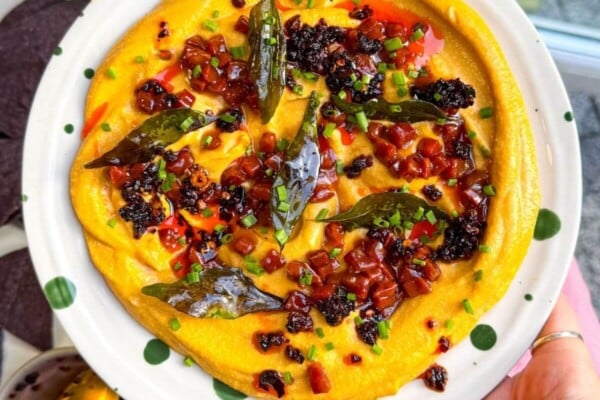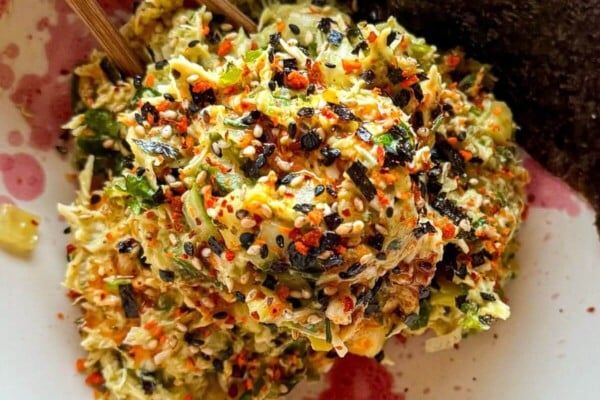This lusciously creamy baked peanut satay ramen is a cozy, protein-packed dinner that basically cooks itself. A ‘dump and go’ meal tailor-made for busy weeknights – throw everything, including your noodles, into a dish and let your oven do all the work. It’s the kind of recipe that feels slow-cooked (that flavor!) but secretly takes just 30 minutes.
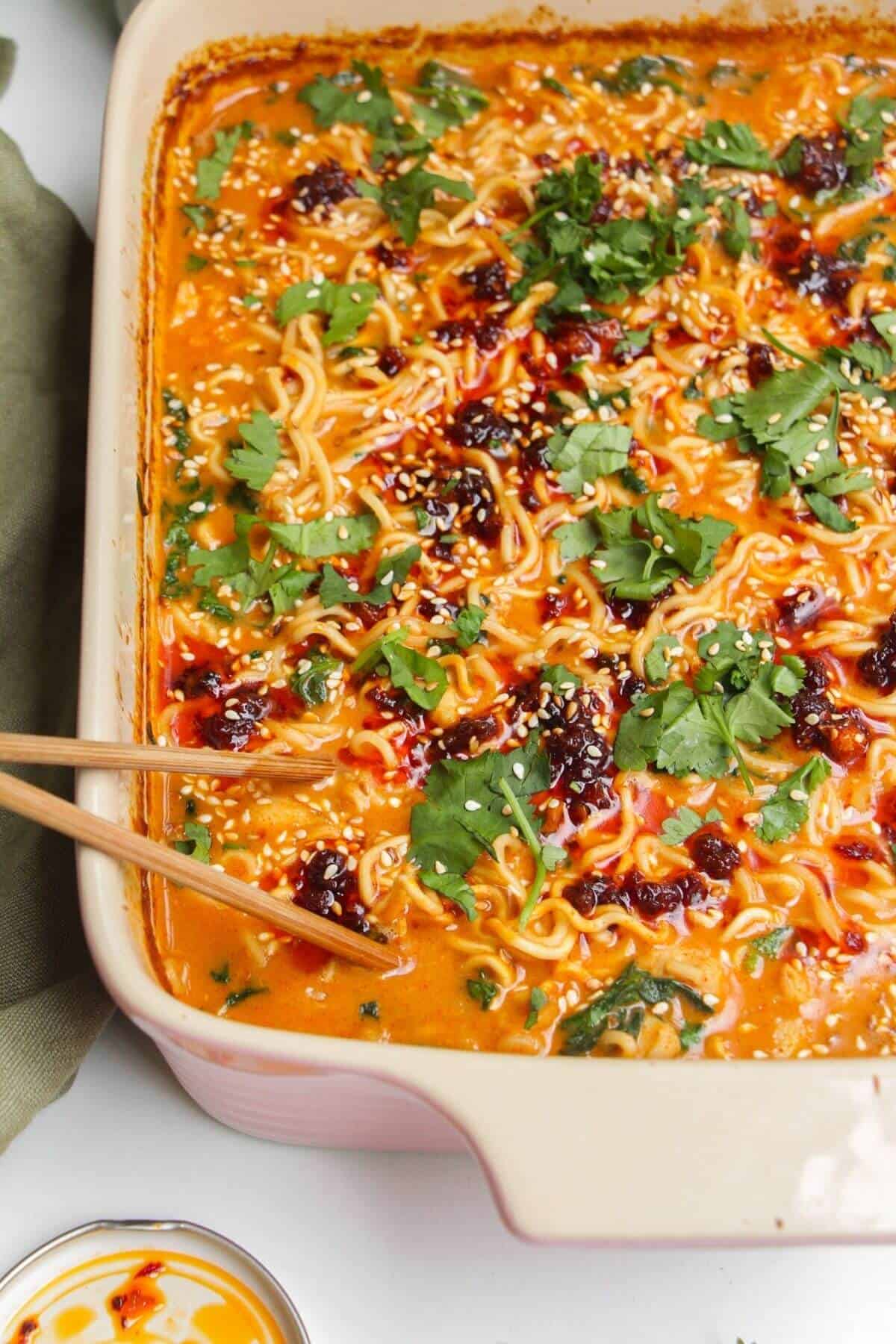
There isn’t a lot I love more than a big bowl of saucy, slurpy noodles, and things don’t get much easier than this ridiculously simple ‘dump and go’ satay inspired ramen. It’s the kind of recipe that’s genuinely achievable when you really can’t be bothered to cook – there’s hardly any hands-on time, and you’re left with a cozy, nourishing bowl of comfort you’ll come back to again and again.
This beauty is very similar, flavor-wise, to these lovely one-pot quick spicy coconut noodles, these one-pot saucy peanut satay noodles, and these very easy one pot baked satay dumplings, so if you like the sound of this recipe, I think you’ll love those too!
Why You’ll Love This Recipe
- It’s totally hands-off. No stirring, no need to cook the noodles separately, no babysitting the stove – just mix, bake, and let your oven do the work for you.
- Endlessly customizable. Swap the chicken breast for leftover shredded rotisserie chicken, crispy slow-roasted pork belly, frozen shrimp, tofu, white beans, or chickpeas, and add more of your favorite veggies.
- Fabulous for busy weeknights. 30 minutes from start to finish means these lovely noodles are an easy, family friendly meal for those busy days you can’t face too much effort in the kitchen.
Ingredients You’ll Need
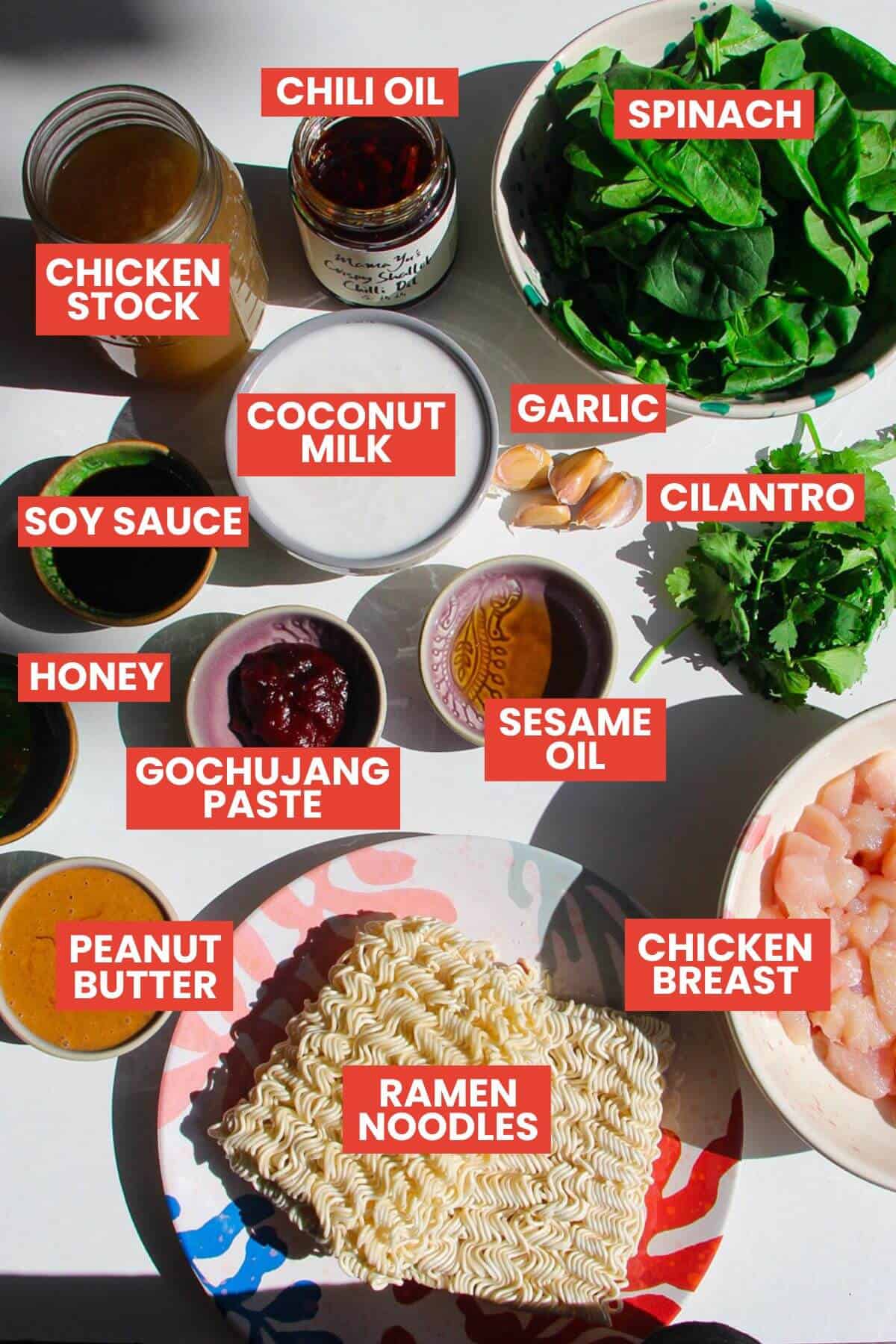
- Coconut milk. I recommend using coconut milk (you want the one in the can), with a high percentage of coconut extract. Look for anything 60% and above for the best, creamy flavor and thick consistency.
- Ramen noodles. I’m using two regular packets of instant ramen (I’ve discarded the flavor sachets). But you could use any dried noodles you like here.
- Gochujang paste. This sweet, spicy, umami-heavy Korean fermented chili paste adds such a lovely depth of flavor to the noodles. You’ll find it in the Asian food aisle at the grocery store, or you can pick it up from Amazon. If you can’t find it, you can use red curry paste or sriracha instead.
- Peanut butter. For the best flavor, I recommend using high-quality peanut butter that just lists peanuts and salt in the ingredients.
- Chicken breast. Use chicken thighs if you prefer, or you could even use shredded cooked chicken (or a rotisserie chicken). If you use cooked chicken, add it after stirring the noodles and before returning them to the oven. You can also skip the chicken completely for a vegetarian version.
- Spinach. You can really use any leafy green here – shredded kale, sliced bok choy, pak choi, or even broccoli.
How to Make Baked Peanut Satay Ramen
This is a step-by-step photo overview of how to make the baked ramen – the full recipe with instructions and ingredient quantities is at the bottom of the page for you.
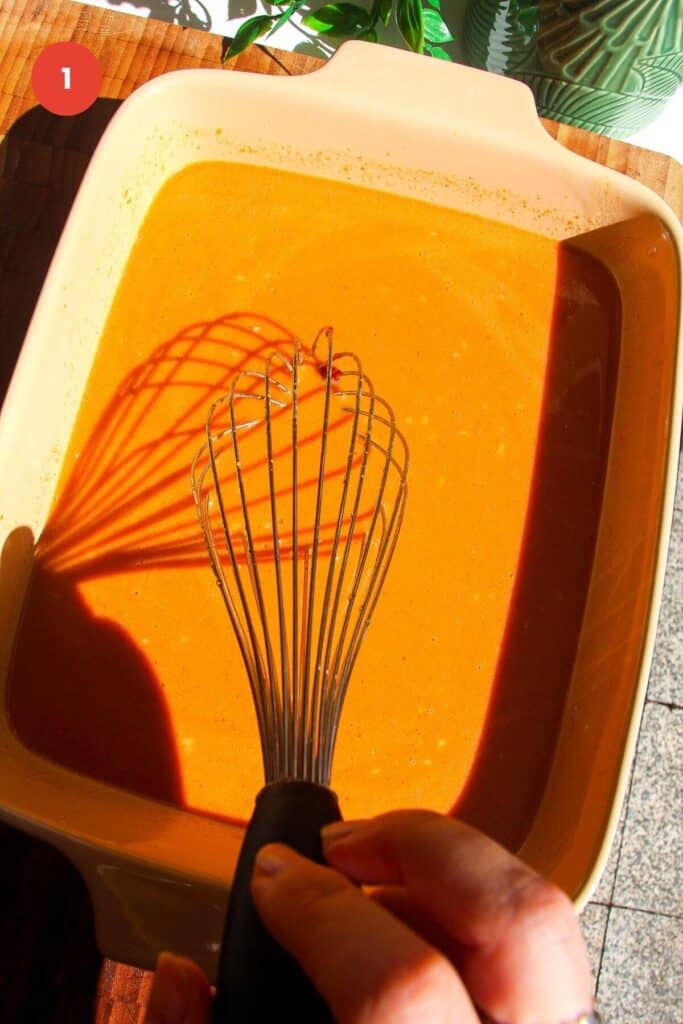
1. Add all your sauce ingredients (coconut milk, gochujang paste, peanut butter, honey, soy sauce, sesame oil, garlic, and ginger) to a baking dish, then whisk to combine into a smooth sauce.
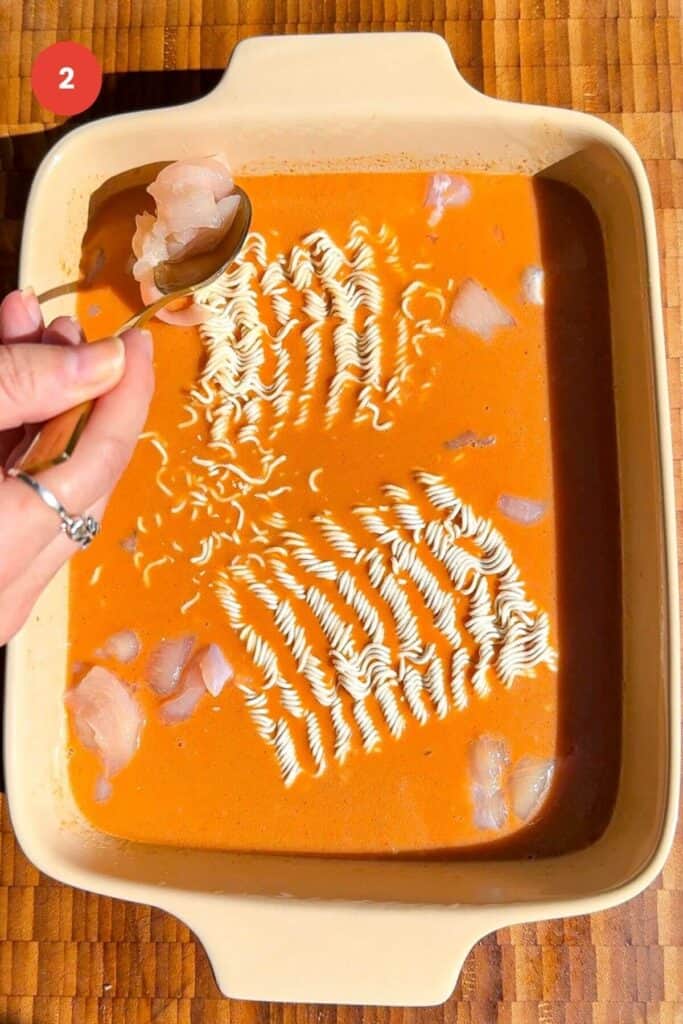
2. Arrange the ramen cakes and the diced chicken in the sauce.
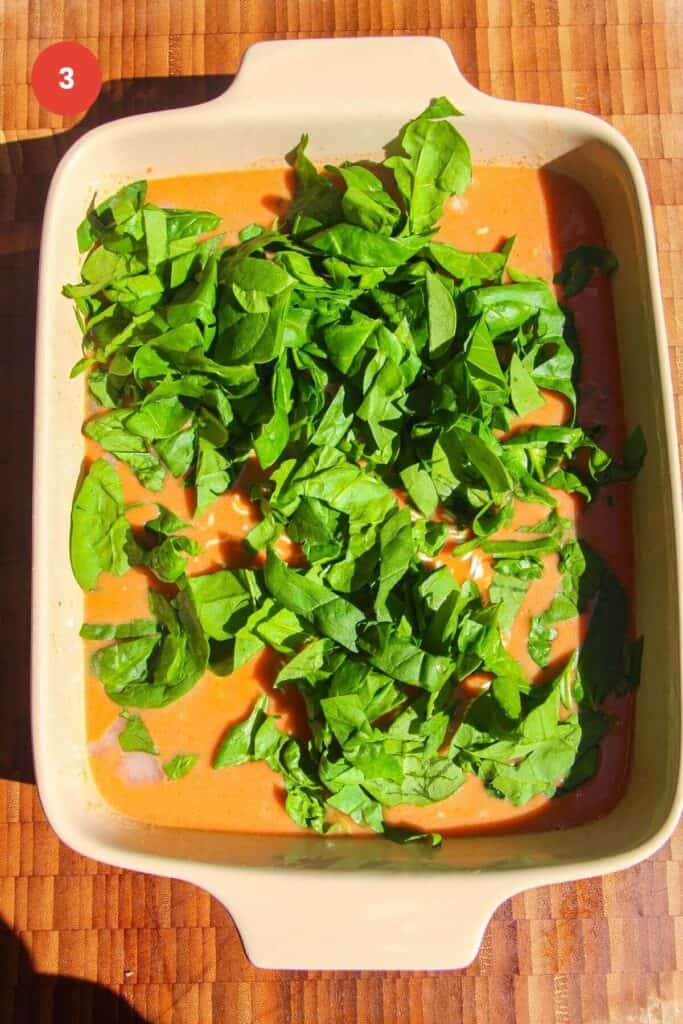
3. Scatter your spinach leaves on top.
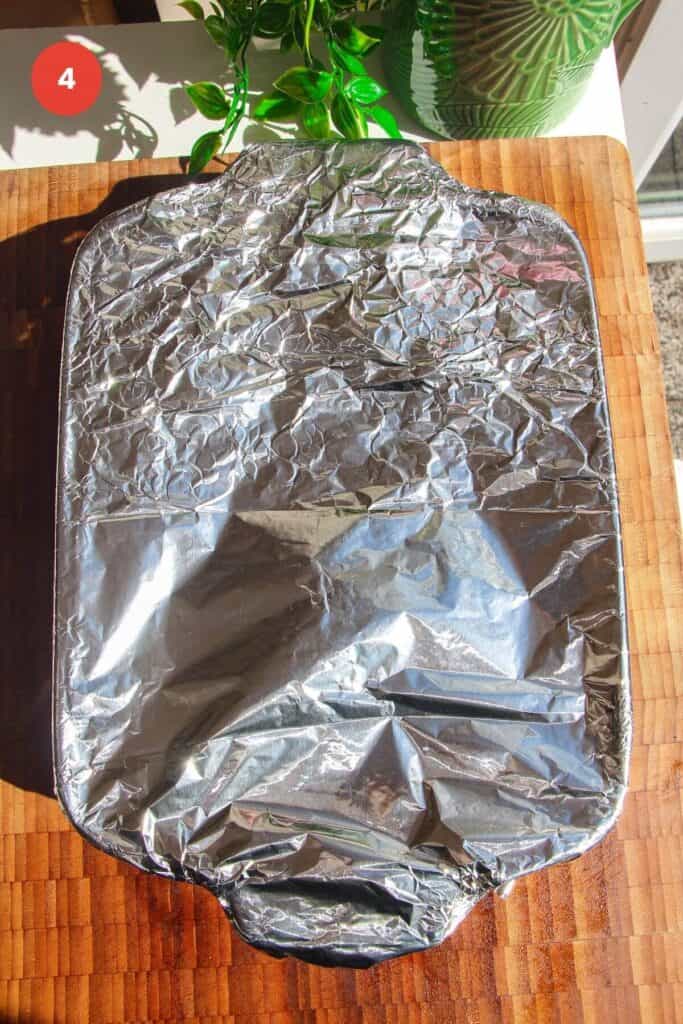
4. Tightly cover your dish with aluminum foil, then transfer to the oven.

5. Remove the foil, then give everything a mix through the sauce.
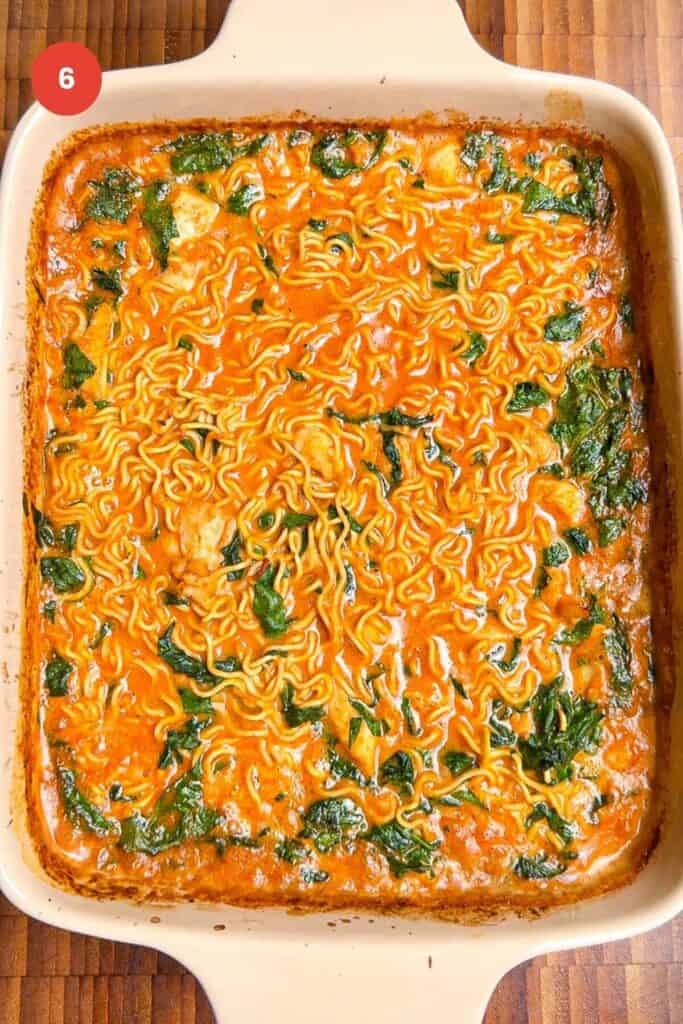
6. Return the dish to the oven until the chicken and the noodles are cooked through and the sauce is gorgeously thick and creamy.
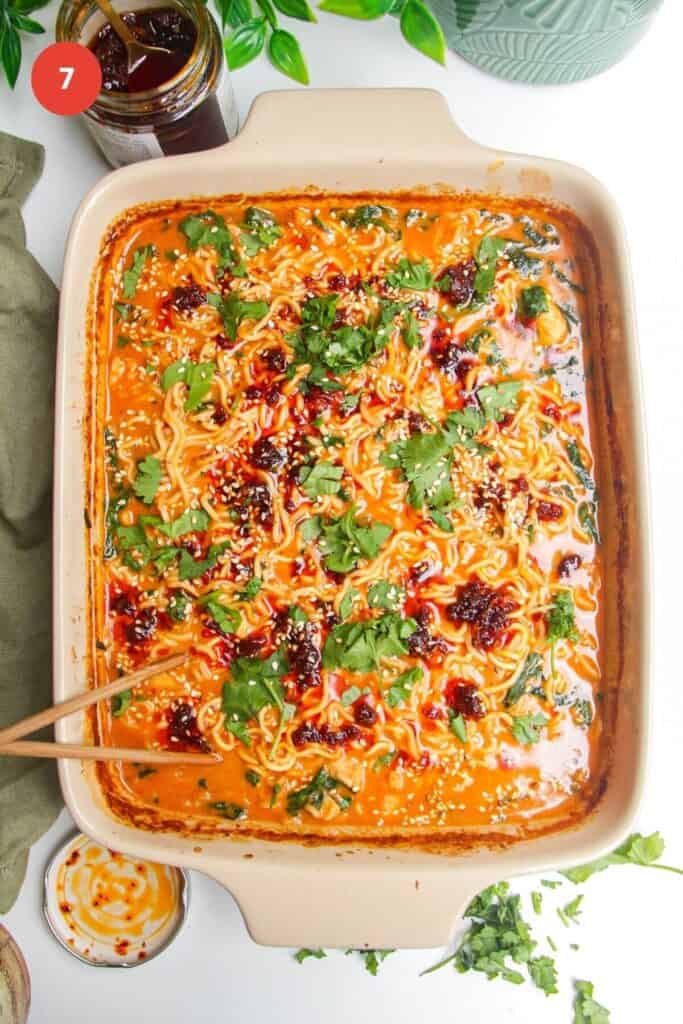
7. Dollop the chili oil over the ramen, then sprinkle with sesame seeds and cilantro.
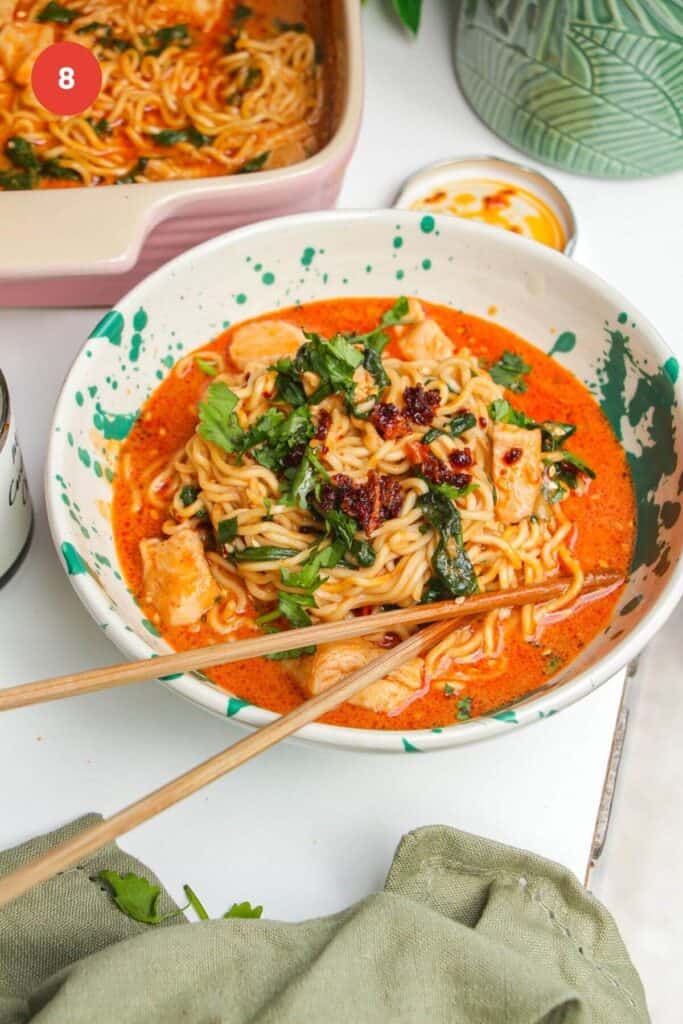
8. Divide the noodles, chicken, and spicy satay coconut sauce between bowls and enjoy while hot.
Baked Peanut Satay Ramen FAQs
You can, but you might need to make a couple of adjustments. Instant ramen bricks (like I’m using in the recipe) are perfect, as are any other wheat-based dried or quick-cooking noodles.
– If you use fresh noodles, you’ll want to reduce the stock slightly because they won’t absorb as much liquid as dried noodles will (this means your sauce will be looser).
– If you use dried rice or soba noodles, you’ll want to add a little more stock as they absorb liquid a little differently.
No, you don’t – it cooks. directly in the sauce in the oven. Just make sure you slice your chicken into small, thin, even pieces to ensure they cook properly.
Alternatively, you can toss in some shredded cooked or rotisserie chicken halfway through the cooking time (stir it through the noodles and sauce when you give them a mix and remove the foil).
Of course! Broccoli, bok choi, frozen peas, or frozen mixed vegetables are great options to go for.
Like this recipe? Try these cozy favorites next
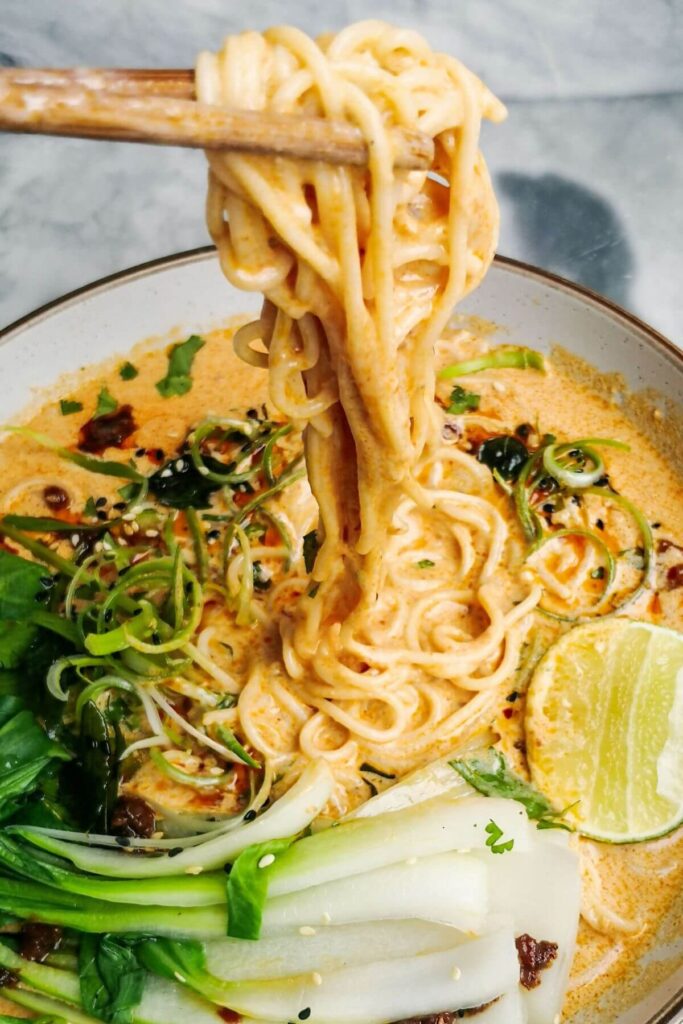
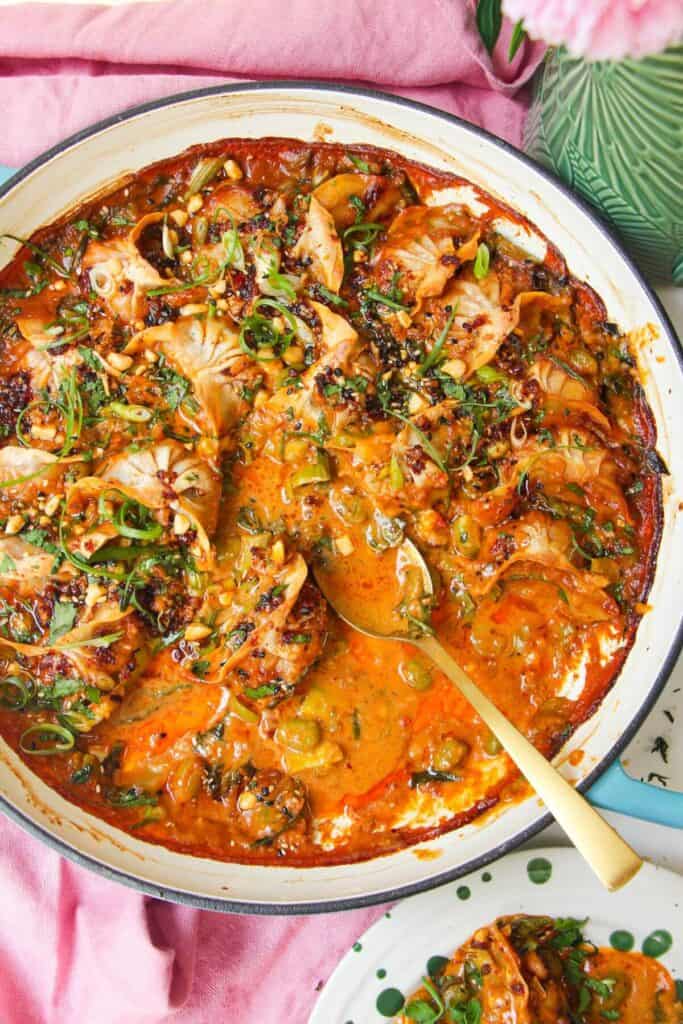
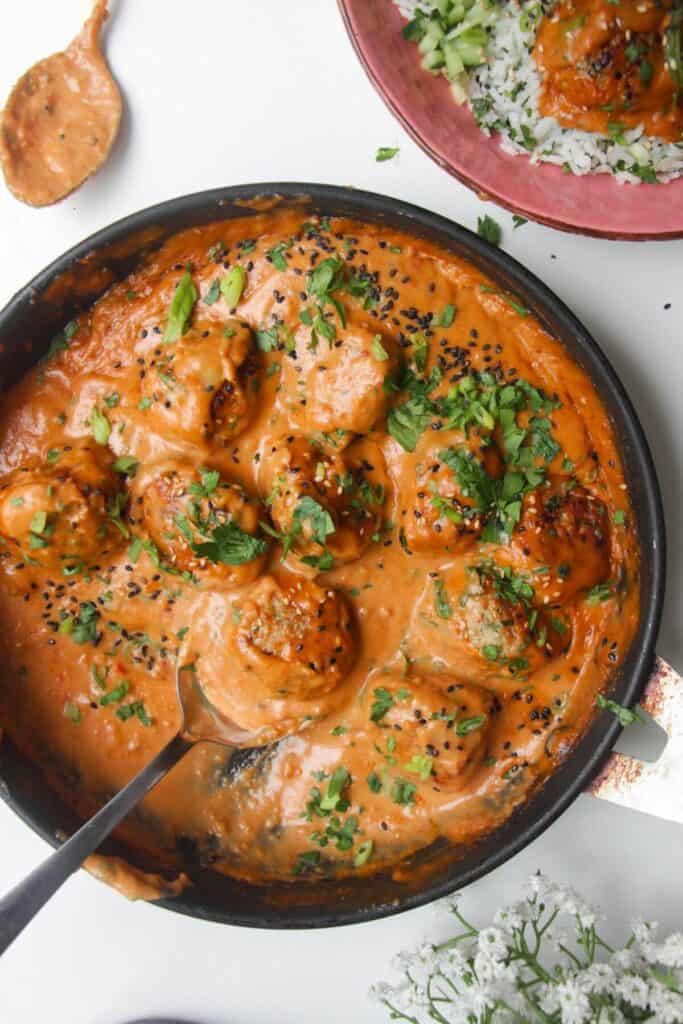

If you make this recipe, I’d love to hear from you! You can leave a recipe rating and a comment below. And remember to tag @DishedByKate on Instagram, Facebook and TikTok if you’ve made one of my recipes. Seeing your recreations really makes my day 😊.
Print
Easy Baked Peanut Satay Ramen (In 30 Minutes)
- Total Time: 30 minutes
- Yield: 4 servings 1x
Description
This lusciously creamy baked peanut satay ramen is a cozy, protein-packed dinner that basically cooks itself. A ‘dump and go’ meal tailor-made for busy weeknights – throw everything, including your noodles, into a dish and let your oven do all the work. It’s the kind of recipe that feels slow-cooked (that flavor!) but secretly takes just 30 minutes.
Ingredients
For the baked satay ramen –
- 1 can of coconut milk (400ml or 13.5 fl oz)
- 1 1/2 cups chicken stock (or use vegetable stock)
- 2 tablespoons gochujang paste
- 3 tablespoons peanut butter
- 2 tablespoons light soy sauce
- 2 teaspoons sesame oil
- 1 tablespoon honey
- 1-inch piece of ginger, grated
- 3 garlic cloves, crushed
- 8.5oz (240g) ramen noodles (I use two packets, with the flavor sachets discarded)
- 1/2 lb (250g) thinly sliced skinless, boneless chicken breasts (or use chicken thighs)
- 2 big handfuls of spinach
To serve –
- Chili oil
- Sesame seeds
- A handful of cilantro leaves
- 2 scallions, finely sliced
Instructions
- Mix the coconut satay sauce. Start by heating your oven to 400°F (200°C fan). To a baking dish, add the coconut milk, 1 ½ cups chicken stock, 2 tablespoons gochujang paste, 3 tablespoons peanut butter, 2 tablespoons light soy sauce, 2 teaspoons sesame oil, 1 tablespoon honey, the grated ginger, and crushed garlic. Use a whisk to mix them into a smooth, cohesive sauce.
- Add the noodles. Place your ramen noodles into the sauce, pressing down so they’re mostly submerged. Scatter the diced chicken around the noodles into the sauce, the arrange the spinach leaves on top. Cover tightly with aluminum foil, and pop into the oven for 15 minutes.
- Mix the noodles. After 15 minutes, remove the dish from the oven, take the foil off, and use a fork or chopsticks to loosen and mix the noodles through the sauce. Pop the uncovered dish back into the oven for another 10 minutes, until the sauce is bubbling and nicely thickened.
- Garnish and serve. Remove the dish from the oven, then drizzle with the chili oil, scatter with the cilantro, sliced scallions, and sesame seeds. Divide the noodles, chicken, and broth between bowls and enjoy while hot.
Notes
INGREDIENT NOTES: Use any dried noodles you like – wheat and egg based noodles are best. If you use rice noodles, you’ll want to reduce the amount of stock a little as they won’t absorb as much liquid. Make sure you slice your chicken thinly so it can cook in the sauce. If you can’t find gochujang paste, use red curry paste. Crunchy or smooth peanut butter is fine – and I recommend using natural peanut butter that lists just peanuts and salt in the ingredients list.
SUBSTITUTIONS AND ADDITIONS: Swap the peanut butter for sunflower seed butter, or tahini, for a nut-free version. You can leave the chicken out if you like, or use frozen shrimp, tofu, or white beans. Add your favorite veggies – broccoli, bok choi, frozen peas, or frozen mixed vegetables are great options.
MAKE AHEAD TIPS: The noodles will continue to absorb the sauce as it sits, so you’ll want to loosen the sauce up with a little stock or water when you reheat it. It’ll keep well for up to 3 days in the fridge.
- Prep Time: 5
- Cook Time: 25
- Category: better than takeout
- Method: oven
- Cuisine: asian
Nutrition
- Serving Size: 200g
- Calories: 480
- Sugar: 7g
- Sodium: 950mg
- Fat: 24g
- Saturated Fat: 13g
- Unsaturated Fat: 10g
- Trans Fat: 0g
- Carbohydrates: 38g
- Fiber: 4g
- Protein: 28g
- Cholesterol: 55mg


